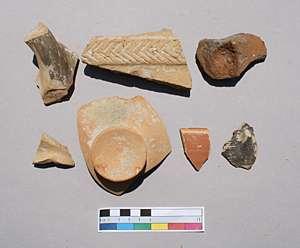UNIVERSITY OF CINCINNATI
Source - http://www.eurekalert.org/pub_releases/2016-01/uoc-ady010616.php?
 The Knossos valley (illustration by permission of Todd Whitelaw).
The Knossos valley (illustration by permission of Todd Whitelaw).
Recent fieldwork at the ancient city of Knossos on the Greek island of Crete finds that during the early Iron Age (1100 to 600 BC), the city was rich in imports and was nearly three times larger than what was believed from earlier excavations. The discovery suggests that not only did this spectacular site in the Greek Bronze Age (between 3500 and 1100 BC) recover from the collapse of the socio-political system around 1200 BC, but also rapidly grew and thrived as a cosmopolitan hub of the Aegean and Mediterranean regions. Antonis Kotsonas, a University of Cincinnati assistant professor of classics, will highlight his field research with the Knossos Urban Landscape Project at the 117th annual meeting of the Archaeological Institute of America and Society for Classical Studies. The meeting takes place Jan. 7-10, 2016 in San Francisco.
Kotsonas explains that Knossos, "renowned as a glorious site of the Greek Bronze Age, the leader of Crete and the seat of the palace of the mythical King Minos and the home of the enigmatic labyrinth," was the prosperous epicenter of Minoan culture. Scholars have studied the city's Bronze Age remains for more than a century, but more recent research has focused on the urban development of the city after it entered the Iron Age -- in the 11th century BC -- following the Bronze Age collapse of the Aegean palaces.
The Knossos Urban Landscape Project over the past decade has recovered a large collection of ceramics and artifacts dating back to the Iron Age. The relics were spread over an extensive area that was previously unexplored. Kotsonas says that this exploration revealed considerable growth in the size of the settlement during the early Iron Age and also growth in the quantity and quality of its imports coming from mainland Greece, Cyprus, the Near East, Egypt, Italy, Sardinia and the western Mediterranean.
 Larger concentrations of better preserved material from the fringes of early Iron Age Knossos typically suggest a fairly recently disturbed burial context (illustration by permission of Todd Whitelaw).
Larger concentrations of better preserved material from the fringes of early Iron Age Knossos typically suggest a fairly recently disturbed burial context (illustration by permission of Todd Whitelaw).
"No other site in the Aegean period has such a range of imports," Kotsonas says. The imports include bronze and other metals -- jewelry and adornments, as well as pottery. He adds that the majority of the materials, recovered from tombs, provide a glimpse of the wealth in the community, because status symbols were buried with the dead during this period.
The antiquities were collected from fields covering the remains of dwellings and cemeteries. "Distinguishing between domestic and burial contexts is essential for determining the size of the settlement and understanding the demographic, socio-political and economic development of the local community," explains Kotsonas. "Even at this early stage in detailed analysis, it appears that this was a nucleated, rather densely occupied settlement extending over the core of the Knossos valley, from at least the east slopes of the acropolis hill on the west to the Kairatos River, and from the Vlychia stream on the south until roughly midway between the Minoan palace and the Kephala hill."
Kotsonas' Jan. 9, 2016 presentation is part of a colloquium themed, "Long-Term Urban Dynamics at Knossos: The Knossos Urban Landscape Project, 2005-2015." Kotsonas serves as a consultant on the project, which is dedicated to intensively surveying the Knossos valley and documenting the development of the site from 7000 BC, to the early 20th century. The project is a research partnership between the Greek Archaeological Service and the British School at Athens. Kotsonas has served as a collaborator on the project since 2009.